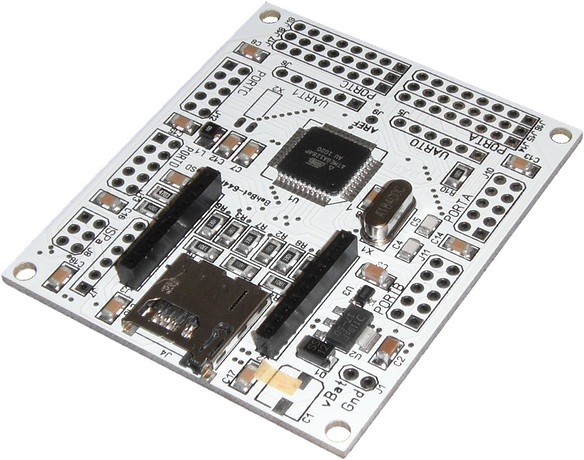This is a review of the BahBots 1284p controller board designed by:
Glen Aidukas and Eddy Wright
Unboxing:
I didn't find anything out of the ordinary when unpacking. Board, headers and a 9v snap connector terminated in a Molex plug and coresponding jack for the board. Populating the board was quite easy as it only needed the pins to be soldered. All the surface mount parts came soldered to the board. The board is white, which does not change anything at all but hey --when was the last time you saw a white board? Total time to solder all the pins was less than 15 minutes.
The board itself:
The board looks good with a good soldermask and great mounting holes. The 4 "corner" mounting holes match the stuff from Tamiya and will bolt right on with the addition of some PCB standoffs. Proto boards are available that match the footprint of the main board. All the pins are easily accessable and the arangement is good however, the individual pins are not labled on the board (This may be addressed with version 2). Both serial ports are broken out to a 6-pin arrangement and there are headers for ISP both 6-pin-straight and 3x3 side-by-side. The SD card slot is the "clicky" kind that will "eject" the card when pushed.
All general use I/O pins are broken out into 10-pin packs with the 8 pins of each port plus power and ground. In addition, port A and port C are broken out at the bottom of the board into 3-pin "servo style" connectors. The power going to the A and/or C ports is jumper selectable via solder pads on the back of the board and can be supplied with raw power from the battery or 5v regulated from the onboard voltage regulator. The voltage regulator is rated at 500mA or 1 full amp if you stick a little heatsink on top. The Xbee module straddles the SD card and is not in the way.
I would like to see a LED (for power) and a reset switch, again, these issues may be dealt with in version 2.
Brains and special Tricks:
The AtMega1284p chip is big, fast and has a lot of thinkin' room.
- 32 I/O pins
- 8 ADC's
- 8 PWM's
- 2 UART Serials
- 128k program space
- 16k RAM
- 18.432 Mhz
- 2 8-Bit timers
- 2 16-Bit timers
- 5v Onboard regulator 1A (500mA w/o heat sink)
- 3.3v Onboard regulator 250mA (to power SD card, Xbee, and is included in both serial UART's)
I had no idea how handy to have and fast SD cards were. With a Sandisk brand card, I am averaging a little less than 200kbs write-times. The board will also play .WAV files directly from the board with no external parts via a PWM output. If you choose not to use the SD card and want "its pins back" you can --there are jumpers that can be "unjumped" to give you access to these pins. In addition, the Xbee can be connected to serial 0 or serial 1 via jumpers.
The unit comes "speaking" BASCOM and will work with all the AVR-friendly languages out there. In addition, the Arduino language can also be installed and works quite well with the Arduino IDE.
Now the cool thing... Wireless bootloading:
With the optional USB/Serial/Xbee board and a couple of Xbee's, one can send programs from the IDE to the board wirelessly as well as send serial data bi-directionally. The comunication is at 38,400 baud and is quick enough for anything I can think I would ever use. The syncing of programs from IDE to board is as clean and fast as a hardwire sync and you will very quickly get spoiled. As soon as you sync the first time wirelessly, you will A) never want to go back to a cord and B) wish all your boards could do this. I can't say enough about wireless "jzinking" of code from computer to 'bot... Awesome, simply awesome.
Get it:
(By the way, Wright Hobbies also sells crimpable servo connectors in 2,3,4,5 and 6-pin arrangements! )
Overall:
Yup, I like this board. I like the option of pin arangement for the I/O pins, I love the SD card (I will never use EEPROMs ever again) and I adore the wireless bootloading. At 35 bucks, you get every penny of value you paid. I would like to see some LEDs, a reset switch and maybe a beefier voltage regulator and I would give it a 8+ or a 9...
Until then, I give this board a solid 8.
https://www.youtube.com/watch?v=C7yVKlBj2uk


